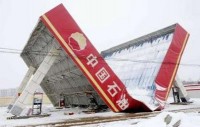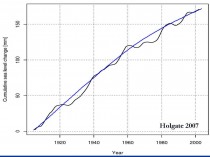BEIJING - See these stories on the killer cold and snow in China here and here. Unusually early snow storms in north-central China have claimed 40 lives, caused thousands of buildings to collapse and destroyed almost 500,000 acres (200,000 hectares) of winter crops, the Civil Affairs Ministry said Friday. Nineteen of the deaths resulted from traffic accidents related to the storms that began Nov. 9, the ministry said in a statement on its Web site. The snowfall is the heaviest in the northern and central provinces of Hebei, Shanxi, Shaanxi, Shandong and Henan since record keeping began after the establishment of the Communist state in 1949, the ministry said without giving detailed figures. It estimated economic losses from the storm at 4.5 billion yuan (US$659 million).

Chinese state media say some of the snow was induced through cloud seeding, although the precise amount of snowfall in all areas was not reported and it wasn’t clear what the previous records were. Hebei’s provincial capital, Shijiazhuang, received the heaviest snowfall - 3.7 inches (9.4 centimeters) - on Nov. 10, the day of the heaviest flurries.

More than 7.5 million people have been stranded or otherwise affected by the storms, which caused the collapse of more than 9,000 buildings, damaged 470,000 acres (190,000 hectares) of crops, and forced the evacuation of 158,000 people, the ministry said. State media have reported at least two deaths were caused by the collapse of buildings, including a school cafeteria. Beijing has been hit by three successive waves of snow, causing havoc on roadways and forcing the cancellation or delay of scores of flights.
The capital and surrounding areas are little prepared to deal with such heavy snow, with few plows or road deicing supplies. Snow tires and chains are almost unknown and many drivers simply leave their cars at home and turn to public transport in such conditions. The impact has been far greater in the surrounding provinces of Hebei, Shanxi, Shaanxi, Shandong and Henan, where highways have been closed, schools shuttered, and crews sent to rescue people in their snowbound homes.
Freak snow and ice storms last year hit parts of eastern and southern China unaccustomed to such weather. Those storms paralyzed key transport systems just as millions of migrant workers were heading home for the Lunar New Year holiday, leading to more than 80 deaths and billions of dollars in damage.
-----------------------------
Lou Dobbs announced his last broadcast at CNN after 30 years. Lou was unique in the world of the mainstream media in that he presented both sides of the global climate change issue. Here, it was disclosed he had 8 million good reasons.
-------------------------------
Weather Jazz: Episode #021, Meteorologist Andre Bernier. Release Date: November 10, 2009 “What does it take in order to put together a long-range winter forecast for the nation?” Join Andre’s former professor of meteorology, Joe D’Aleo for an engaging look at all the parameters that go into it. See page and download episode here. In part II, they will discuss the Weather Channel early days.
Also last week I had the privilege to participate with Dr. Tim Ball and Robert Felix on a fine new internet chat on climate issues on Its Rain Making Time here.
This week David Legates and Willie Soon were interviewed in Its Rainmaking Time in The Truth About Climate & Weather Part 2: The Plot Thickens
.-----------------------------------
Science is in on climate change sea-level rise: 1.7mm
By Drew Warne-Smith and James Madden, The Australian
Sea levels on Australia’s eastern seaboard are rising at less than a third of the rate that the NSW government is predicting as it overhauls the state’s planning laws and bans thousands of landowners from developing coastal sites.
The Rees government this week warned that coastal waters would rise 40cm on 1990 levels by 2050, with potentially disastrous effects. Even yesterday Kevin Rudd warned in a speech to the Lowy Institute that 700,000 homes and businesses, valued at up to $150 billion, were at risk from the surging tide.

However, if current sea-level rises continue, it would not be until about 2200 - another 191 years - before the east coast experienced the kind of increases that have been flagged. According to the most recent report by the Bureau of Meteorology’s National Tidal Centre, issued in June, there has been an average yearly increase of 1.9mm in the combined net rate of relative sea level at Port Kembla, south of Sydney, since the station was installed in 1991.
This is consistent with historical analysis showing that, throughout the 20th century, there was a modest rise in global sea levels of about 20cm, or 1.7mm per year on average. By comparison, the NSW government’s projections - based on global modelling by the Intergovernmental Panel on Climate Change as well as CSIRO regional analysis - equate to a future rise of about 6.6mm a year. Such a projection has caused widespread concern for landowners and developers, derision from “climate sceptics” within the scientific community and even some head-scratching from Wollongong locals such as Kevin Court, 80.
“I have swum at this beach every day for the past 50 years, and nothing much changes here,” Mr Court said yesterday as he emerged from the surf at Wollongong’s North Beach, just a short paddle from the Port Kembla gauging station. “All this talk about rising sea levels - most of us old-timers haven’t seen any change and we’ve been coming down here for decades.
“A few years ago part of the bank at the back of the beach was eroded. But you look at it now, and all the grass has grown back over it. The water hasn’t washed back there for years. “And that’s nature. It’s up and down, it comes and goes in cycles - nothing dramatic.”
The complex task of tracking sea levels is being performed by the Australian Baseline Sea Level Monitoring Project, which is co-ordinated by the National Tidal Centre. The project operates 16 gauging stations around the country, with the eastern seaboard monitored by stations at Port Kembla, as well as Rosslyn Bay and Cape Ferguson, in Queensland.
Bob Carter, a geologist and environmental scientist with James Cook University in Queensland, said he was “baffled” as to why states and local councils would develop policy based primarily on global averages and not the records of local tidal gauges. In the past year, the Port Kembla gauge has recorded a sea-level rise of just 0.1 mm. “When you design a house in Sydney, do you entrust the architect and builder to do the heating and air-conditioning based on global average temperature? Of course not,” Professor Carter said.
He added that even if seas were rising as much as 3.3mm a year - the CSIRO’s current global estimate - they would remain within the bounds of natural and normal variation. “There have been lots of times in our history when sea levels rose as much or more than now,” Professor Carter said. “There is nothing unusual in the current situation.”
Meteorologist Bill Kininmonth, former head of the National Climate Centre, is another to express concern about the way future sea-level rises have been modelled. Mr Kininmonth believes only a thin layer of the ocean is actually warming - about 200m - making it unlikely the oceans are expanding to any great degree. He said there was little compelling evidence that the polar caps were melting and causing sea levels to rise.
Computer models also tended to underestimate the way evaporation regulated temperature, thereby exaggerating future temperature predictions, Mr Kininmonth added. “There’s little reason to think the little bit of extra heat generated by greenhouse gases will make a dramatic difference,” he said.
However, the consensus view of the scientific community remains that sea-levels are rising at an accelerated rate because of human activity that has warmed Earth. The CSIRO’s John Church, considered one of the world’s leading authorities on sea-level rise, told The Weekend Australian yesterday he remained convinced waters along the eastern seaboard were rising in line with global averages. He noted that the BOM’s gauge results for Port Kembla as published here did not include the effect of barometric pressure, which, if included, would lift the sea-level increase to 3.1mm, not much less than agreed global estimates.
The Australian continent was also rising slightly - about 0.3-0.4mm a year around Sydney - which had partially offset increases in sea levels, he said. And an analysis of records from a gauge at Fort Denison in Sydney Harbour - not incorporated in the National Tidal Centre report - also revealed that, after 1950, periods of extreme sea-level rises occurred three times as frequently as in the first half of that century.
“There is a clear acceleration in the rate of sea-level rise,” Dr Church said. “In the last 20 years, it’s almost twice the global average for the 20th century.” Dr Church said the NSW coast was likely to experience sea-level rises greater than global estimates due to changes in the wind stress patterns in the Pacific Ocean, which will strengthen the East Australian Current. And if polar ice caps were indeed melting at a significant rate - which is not yet established - Australia could witness even bigger swells still.
Dr Church challenged Mr Kininmonth’s assertion that only a thin surface layer of the ocean was warming, saying recent studies provided evidence of deep ocean warming although it couldn’t be quantified as yet. A spokesperson for the NSW Department of Environment, Climate Change and Water said NSW had selected the upper end of the IPCC modelling predictions because both emissions and measured global sea-level rise were now at or above the upper IPCC estimates. See post here.
Icecap Note:
Sea levels globally have slowed (below, enlarged here) in recent decades (Holgate 2007) despite what the ‘leading expert’ Church says:


See sea level rise slow even more after 2006 according to the University of Colorado (enlarged here). To these clowns in the institutions and governments reality is not data but the models.
See in this New Zealand Climate Truth Newsletter by Dr. Vincent Gray how the oceans are inconveniently cooling and evidence exists that they are heated from below.




